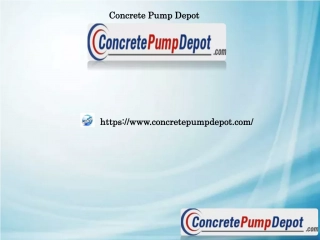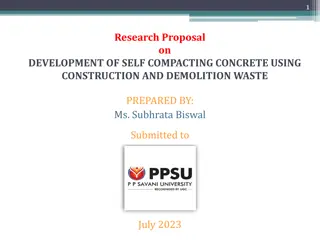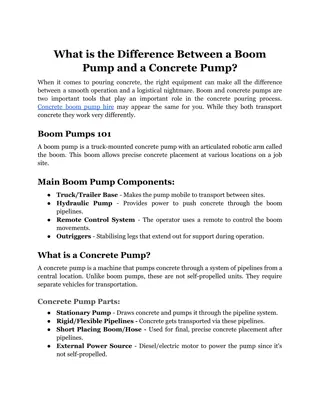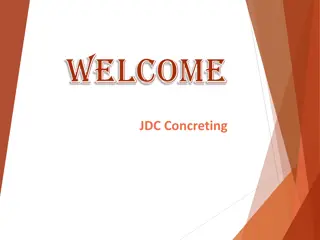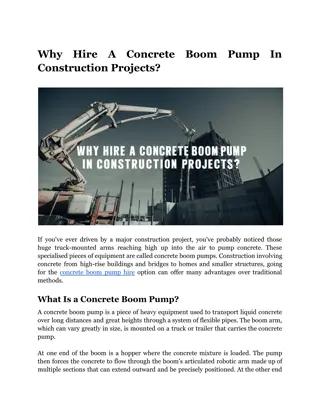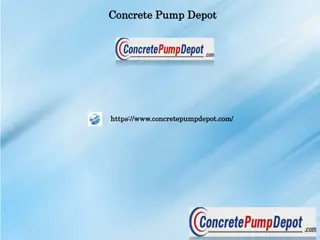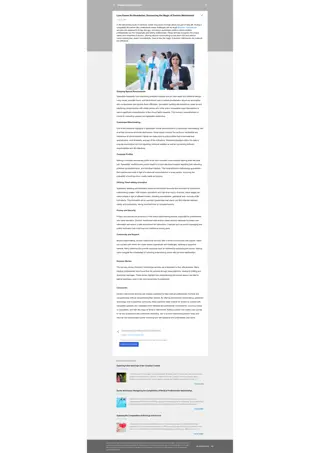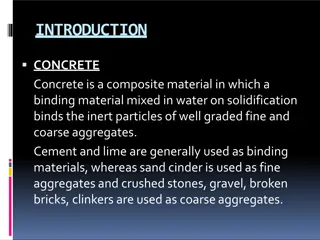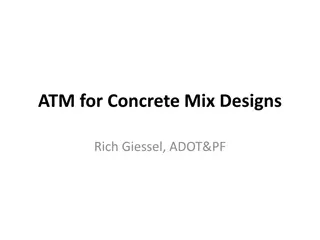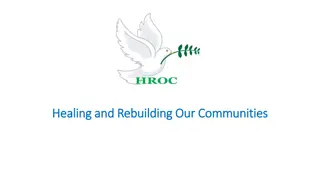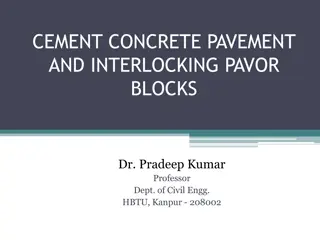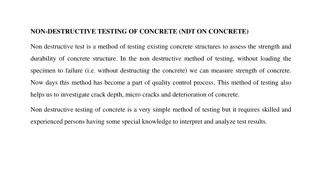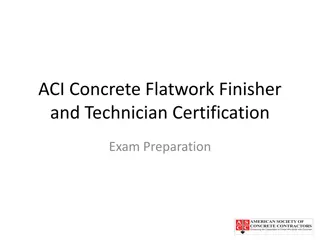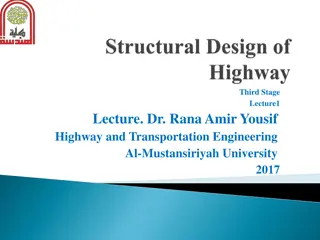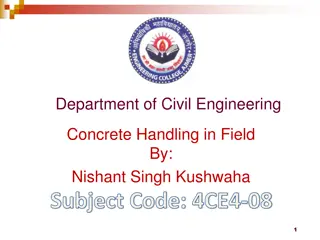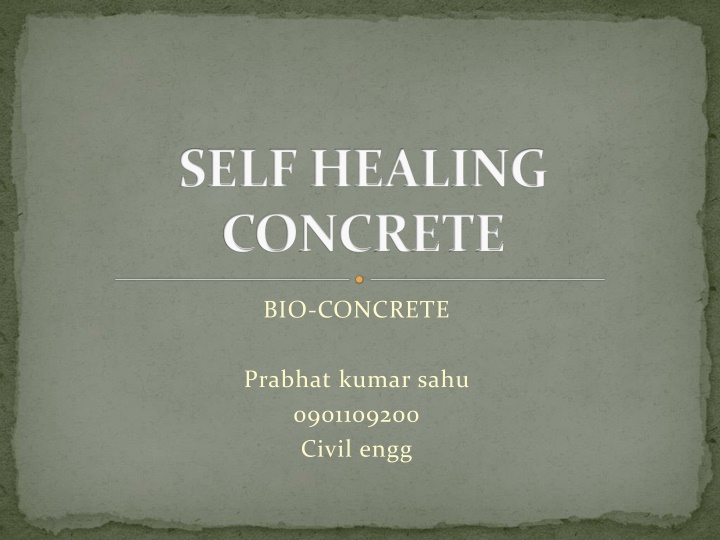
Innovative Self-Healing Concrete Technology for Sustainable Construction
Discover how bio-concrete with self-healing properties, utilizing Bacillus subtilis bacteria, can enhance the durability and maintenance of concrete structures. Explore the experimental program, objectives, procedures, and chemical reactions involved in this cutting-edge construction solution.
Download Presentation

Please find below an Image/Link to download the presentation.
The content on the website is provided AS IS for your information and personal use only. It may not be sold, licensed, or shared on other websites without obtaining consent from the author. If you encounter any issues during the download, it is possible that the publisher has removed the file from their server.
You are allowed to download the files provided on this website for personal or commercial use, subject to the condition that they are used lawfully. All files are the property of their respective owners.
The content on the website is provided AS IS for your information and personal use only. It may not be sold, licensed, or shared on other websites without obtaining consent from the author.
E N D
Presentation Transcript
SELF HEALING CONCRETE BIO-CONCRETE Prabhat kumar sahu 0901109200 Civil engg
INTRODUCTION Concrete is the most widely used material for construction. It has low tensile strength than compressive strength. So is most effective when reinforced by steel bars. Concrete is a brittle material with low tolerance for strain.
So it forms cracks, leading to corrosion water ingress Decrease in durability increasing maintenance cost self healing concrete is a solution to all above. Here we will induce self healing property using JC3 (Bacillus subtilis) bacteria.
Bacillus subtilis(JC3) JC3 is a gram +ve bacteria Can be cultivated easily in lab with minimum cost It is non- pathogenic
EXPERIMENTAL PROGRAMME Objectives Experimental procedure Chemical reactions Experimental results
OBJECTIVE Analysis of compressive strength with varying bacterial con. Analysis of split tensile strength . Effect of bacterial conc. on different grades of concrete
Procedure JC3 bacteria is added to concrete with Calcium lactate as feeding material. The conc. of JC3 bacteria is proportional to H2O conc. Calcium lactate & JC3 mixture is added in form of palates . Initially JC3 bacteria spores remain in dormant state These spores germinate when come in contact with H2O in temp around 25deg.
When cracks are formed ,the local palates also breaks releasing JC3 Water also seeps through cracks Bacterial spores germinates when comes in contact with H2O JC3 feeds on Calcium lactate forming CaCO3 which precipitates on cracks. This process is known as Microbiologically Induced Calcium Carbonate precipitation(MICCP)
Chemical process MICCP involves a complicated chain of reaction. But can sum up to following two steps Ca2+ + Cell Cell-Ca2+ Cell-Ca2+ + CO32- Cell-CaCO3
Surface 1 :Concrete surface Surface 2 : CaCO3 ptt
Experimental results Cell Conc./ml of water Compressive strength (28 days)(Mpa) 51.81 % increase _ NIL 58.02 11.99 10^4 61.79 10^5 16.15 57.21 10.42 10^6 54.66 5.51 10^7
Compressive strength (28 days) Grade of concrete Controlled concrete (Mpa) Bacterial concrete (Mpa) % increase 28.18 32.74 16.18 M 20 51.19 60.17 17.54 M 40 72.61 94.21 M 60 29.75 93.8 119.2 M 80 27.08
Spliting tensile strength No of days Controlled concrete (Mpa) 3.78 Bacterial concrete (Mpa) 4.30 %increase 13.75 7 4.62 5.28 14.28 14 4.85 5.74 18.35 28
Prctical use The use of Self healing concrete has been very limited world wide . The concept is still in developing stage & on the way to large scale use. In India no use of this has been done. A group of professors in JNTU are researching on bacterial concrete.
CONCLUSION Based on the present experimental investigations, the following conclusions are drawn: decrease of permeability of water and other liquids in concrete. increases the compressive strength of concrete. The compressive strength Splitting tensile strength is increased All over maintenance cost is minimized
From all above results we can consider non pathogenic bacteria as a major material for inducing self healing property in concrete. Now self healing concrete can be said to be future material.
Referrence Wang, J., Van Tittelboom, K., De Belie N., and Verstraete, W.. "Use of Silica Gel or Polyurethane Immobilized Bacteria for Self-healing Concrete." Construction and Building Materials 26.1 (2012): 532- 40.Print. Li, V., University of Michigan, Self-healing concrete for safer, more durable infrastructure. Science Daily,22 Apr. 2009. Web. 28 Feb. 2012. Jonkers, H. M., A. Thijssen, G. Muyzer, O. Copuroglu, and Schlangen, E. "Application of Bacteria as Selfhealing Agent for the Development of Sustainable Concrete." Elsevier. Elsevier B.V., 30 Dec. 2008. Web. 25Feb. 2012.
Brownell, Blaine. "Self-Healing Concrete." Architect, The AIA Magazine (2011): 90-91. Print. O'Driscoll, Cath. "Bacteria Fill in the Gaps in Concrete." Chemistry & Industry (2010). Web. 11 Feb. 2012. Zwaag, S. Van Der, and Schmets A. J. Self Healing Materials: An Alternative Approach to 20 Centuries of Materials Science. Dordrecht, The Netherlands: Springer, 2007. Print. Yonkers, H. M., and E. Schlangen. "Crack Repair by Concrete-immobilized Bacteria." Proc. of First International Conference on Self Healing Materials, Delft University of Technology, Noordwijk Aan Zee. Springer, 2007. Print

